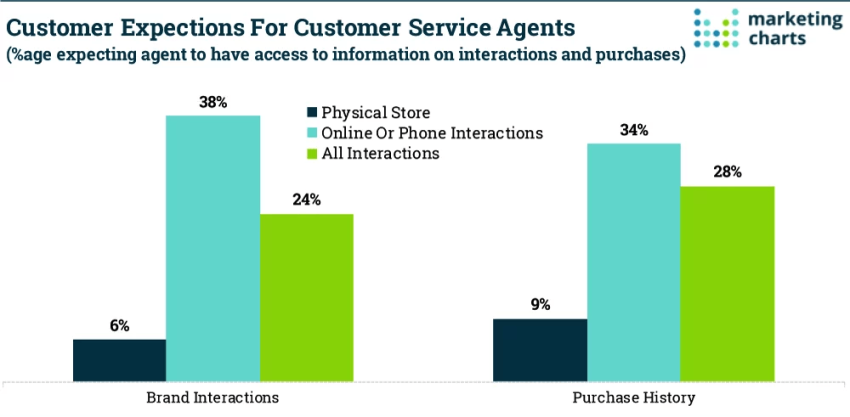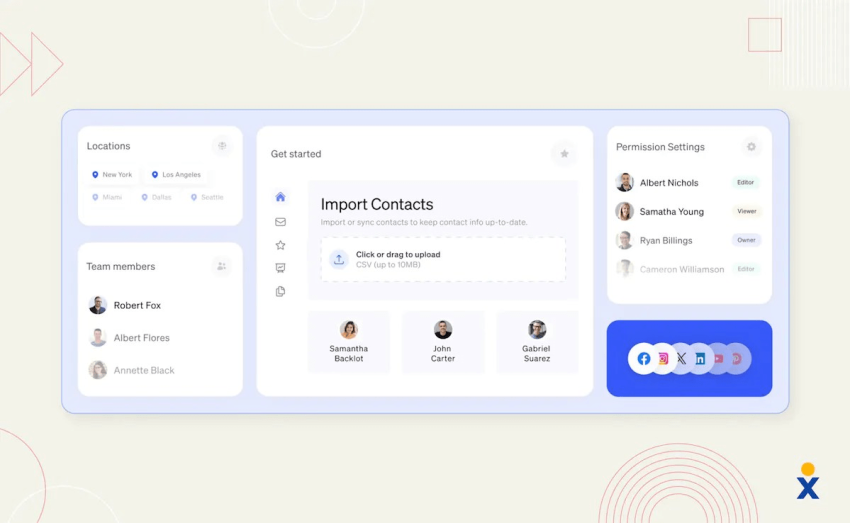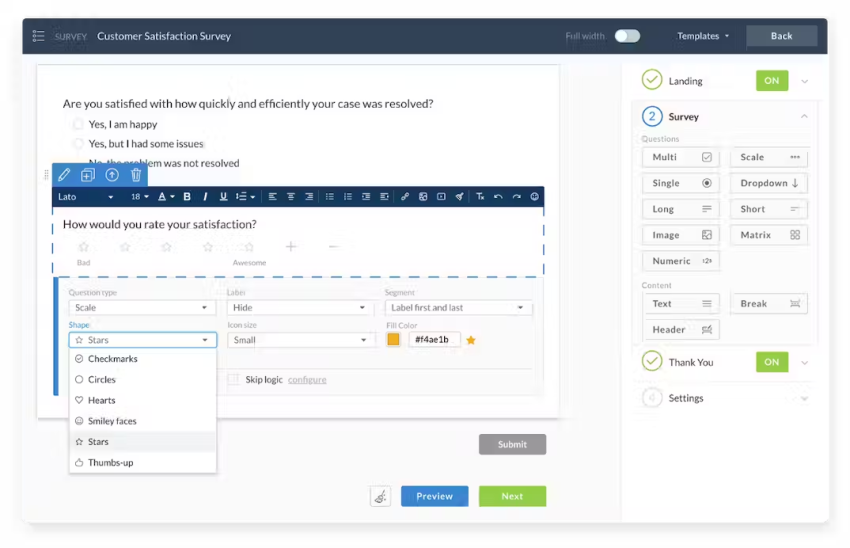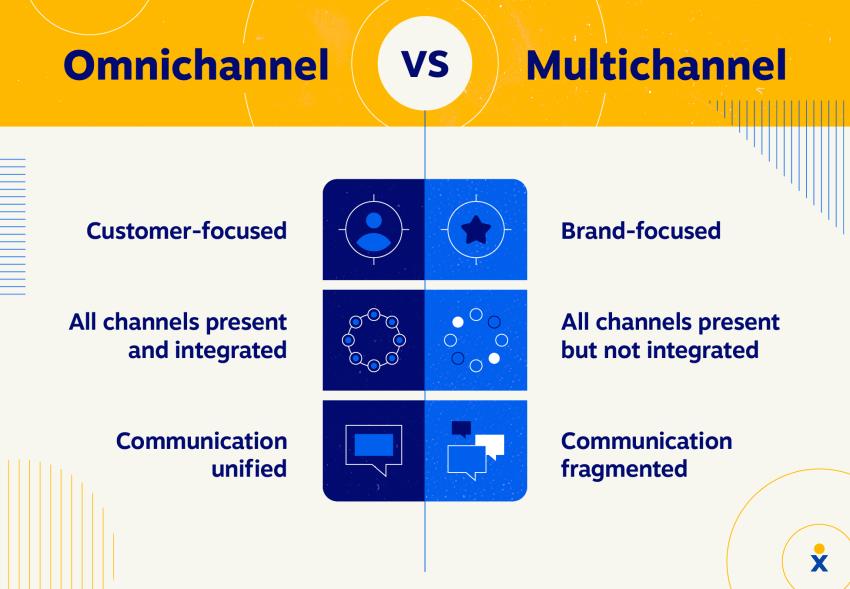How well is your business’ customer service managing customer expectations? Meeting or exceeding these expectations isn’t just a goal – in a world of online reviews and ratings, it’s a necessity for the survival and growth of any company.
To thrive, brands – from small businesses to large enterprises – must excel in areas that resonate with today’s savvy but impatient consumers. These include rapid response times, personalized interactions, consistent, high-quality service across all communication channels, and more. By focusing on these key aspects of customer service, your business can create a significant competitive advantage.
Curious about Nextiva? Watch an instant demo
Get a glimpse of our powerful United-CXM platform in our product demo videos.
This guide walks you through eight fundamental customer expectations and provides best practices to align your customer service with these important demands.
The Importance of Great Customer Service
Customer service is more important than ever:
- 93% of customers say they would make repeat purchases with a business that provides excellent customer service.
- 78% of consumers will do business with a company again even after a mistake – if they had excellent customer service.
- 80% of customers will switch to a competitor after more than one bad experience with a business.
Exceptional customer service is an important factor in a business’s success. With so many options available, consumers can easily switch to your competitors if their expectation is not met. And not just that – it’s also crucial for gathering valuable customer feedback that can drive product and service improvements. Businesses that excel in customer service can turn casual customers into brand advocates, which can better sustain long-term growth.
Keep in mind, however, that just doing the bare minimum – for example, adding all the latest customer communication channels like social media or AI-powered chatbots to your site – won’t automatically turn your poor customer service around if you’re not monitoring them and engaging with your current or potential customers.

Common Customer Service Expectations
Now we present you with eight of the most common expectations that customers have.
1. Personalized experience
Personalized experiences in customer service is increasingly becoming a top expectation among people. About 34% of consumers expect a customer support agent to have access to their purchase history. In fact, not having to repeat oneself (several times, perhaps, if they get transferred to other departments) is one of the most important factors of good customer service.

Therefore, equipping customer support agents with tools – customer relationship management (CRM) software, analytics tools, help desk software – that provide a comprehensive view of a customer’s previous interactions, preferences, and purchase history can dramatically improve the effectiveness of the service provided.
Takeaway: Maintain up-to-date records of all customer interactions with your business. Using cloud-based customer service tools can help make this easier by ensuring that information updates in real-time and that all agents have access to the data.
2. Quick response times
What frustrates respondents most about customer service is not being able to reach a human agent when they need to. And most people aren’t willing to wait more than 2-3 minutes on hold. But 71% of consumers say a quick response from a customer service team leads to an increase in customer satisfaction.
Quick response times are the cornerstone of exceptional customer service. People increasingly expect immediate or near-immediate responses to their inquiries and complaints, and a fast response can be the difference between retaining a happy customer and losing one to frustration and impatience.
Takeaway: To encourage customer loyalty, businesses should prioritize the optimization of their response processes to ensure speed without sacrificing the quality of service. This can be achieved by training staff to handle inquiries efficiently and equipping them with the necessary tools and information.
Additionally, AI-powered contact center tools, including those that use generative AI, can make sure that customers never have to wait on hold very long:
- VoIP Phone Service: Voice over Internet Protocol (VoIP) service allows for efficient call routing and management. This means calls can be quickly directed to the appropriate department or individual without long delays.
- Automated Attendant: The automated attendant feature means that businesses can set up a menu system that helps customers find the right department or information quickly, often resolving simple inquiries without the need for a live agent.
- Call Queues and Routing: Businesses can set up sophisticated call queues and routing systems so that calls are evenly distributed among available agents, which reduces wait times.
3. Fast issue resolution
Answering a customer’s call quickly is not enough. Fast issue resolution is also super important these days to maintain customer satisfaction. When customers encounter problems, how fast a company fixes these issues can play a huge role in earning loyal customers.
Quick and effective resolutions demonstrate a company’s commitment to their customers and can significantly mitigate the negative impact of whatever the initial problem was. This swift responsiveness not only makes for better customer retention, but also enhances the overall perception of the company – which consumers will share with others on social media and review sites.
Takeaway: While customers do want to be able to help themselves via online knowledge bases or chat, when push comes to shove, they still count on the live customer service agent to save the day – fast.
To ensure fast issue resolution, companies need to empower their customer service reps with the right tools and training (like problem-solving skills and in-depth product knowledge). Plus, integrating customer service software in your contact center that provides a complete view of customer interactions and automates routine tasks can help speed up the resolution process.

4. To be heard
About 75% of customers don’t believe that companies really listen to the feedback they provide about customer service.
Many customers feel that their feedback disappears into a void and doesn’t lead to any real change or improvement in services or products. This perception can stem from a lack of visible action on the part of the company or insufficient communication back to the customer about how their feedback is being used.
Companies often collect feedback through surveys, comment cards, and online reviews, but if they do not actually show how this feedback leads to tangible changes, customers might think their opinions are being ignored. This can lead to frustration and decreased loyalty, as they may feel undervalued or not taken seriously.

Takeaway: Make sure you act on customer feedback – and when you do, let customers know about it. For example, if you add new features to your product or service, promote the changes on your website, social media, and in your email marketing, explaining that you’re making these changes based on customer needs. (“You told us X, we listened, and now we’re doing Y.”) You can also “listen” to customers using analytics tools that track call interactions and other data.
5. Transparency and Honesty
Transparency and honesty are key elements in building trust between a business and its clients. Open and honest communication cultivates a sense of integrity and reliability, which are crucial for maintaining long-term relationships with customers.
When mistakes occur, as they inevitably do, customers will generally be more forgiving and understanding when companies admit their errors promptly and are upfront about the steps they will take to resolve the issue.
Takeaway: Businesses can meet customer expectations by creating a culture of transparency in which they openly communicate about both their successes and failures. This includes providing clear information about products and services, being upfront about pricing and return policies, and communicating during crises (such as data breaches) or when problems arise.
Then when a mistake is made, it’s important for businesses to acknowledge it immediately, apologize, and outline how they intend to fix the issue. Implementing policies that encourage and reward honesty in customer interactions (including posting your brand’s privacy statement on your website) can lead to more loyal and satisfied customers.
6. Competence and Efficiency
Consumer expectations include companies being competent and efficient with their customer service or otherwise running their business. Sounds like a no-brainer, right? But not all businesses handle inquiries or issues professionally. Have you ever dealt with a customer service rep who cut you off, argued with you, or gave you different information than a previous rep?
But well-trained, knowledgeable staff will resolve problems effectively, provide accurate information, and maintain a positive interaction experience. The competence of service reps directly influences how customers perceive the reliability and quality of a business.
Takeaway: Meeting customer expectations is easy when customer support staff are competent and efficient, so businesses should invest in comprehensive, ongoing training programs that cover product knowledge, communication skills (like active listening and empathy), and problem-solving techniques.

Plus, empowering employees with the right tools and resources, such as access to a centralized knowledge base and CRM systems, enables them to handle inquiries with greater speed and accuracy. Implementing a customer feedback loop can help call center agents improve their service strategies.
7. Multiple customer service communication options
The most popular methods of customer service are via email and telephone. Following these are online support forums, live chat and physically visiting a business. An omnichannel approach ensures seamless integration across multiple channels, which allows customers to switch between them without losing the context of their interactions.
However, there are some important age-related differences when it comes to your omnichannel customer service strategy. Different age demographics often have distinct preferences: Younger consumers (Gen Z and Millennials) tend to favor instant messaging and social media due to their convenience and speed, while older generations (Gen X and Baby Boomers) tend to prefer traditional channels like phone and email for their reliability and directness.

Takeaway: To implement a seamless omnichannel customer service strategy, businesses need to understand the channel preferences of their key demographic segments and then invest in the necessary technology to integrate these channels.
Customer service representative training that allows your staff to handle queries across all these platforms with equal proficiency is also essential. The key to better customer satisfaction is to provide consistent and efficient service across all platforms, as you’ll build stronger relationships with customers of all ages.
8. Follow-Up Care
Following up after someone calls for help is an important component of customer service expectations that significantly influences the caller’s satisfaction. After resolving an issue, a follow-up email helps verify that the solution was actually effective and that the customer is happy with the outcome. This practice demonstrates a commitment to your customers beyond the immediate financial transaction.
Takeaway: To provide exceptional customer service, businesses should implement structured follow-up procedures as a standard practice in their customer service operations. This might include follow-up emails or calls to confirm that the customer’s issue has been fully resolved, and offers of additional support if needed. Also, soliciting feedback during these follow-ups can provide valuable insights into the effectiveness of the customer service process and highlight areas for improvement.

Nextiva Helps You Meet Customer Service Expectations
As we’ve explored in this guide, meeting the explicit expectations of your customers is essential for delivering exceptional service. Leveraging insights from market research and detailed customer data from your own analytics can profoundly impact how well your business understands and enhances the customer journey.
This is where Nextiva’s call center software comes into play, providing the tools necessary to not only meet but exceed these service benchmarks. Nextiva equips small businesses and bigger brands with a robust framework for achieving superior customer service. By facilitating quicker response times, enabling personalized interactions, and providing a comprehensive view of customer needs, Nextiva helps you deliver the kind of service that keeps your customers coming back.
The call center solution teams love.
Sales and support teams use Nextiva to deliver a better customer experience.
Customer Service Expectations FAQs
Timeliness: Particularly with live chat, customers expect prompt responses to inquiries and quick resolutions to their issues now more than ever.
Accuracy: Providing correct information on your website and offering solutions that actually address the customer’s needs is essential.
Friendliness: Interactions with any customer support team should be helpful and the customer rep should be approachable to create a welcoming experience.
Empathy: People expect a customer service representative to understand and genuinely care about their situation and feelings.
Fairness: Customers want to feel that they are being treated fairly and that policies and procedures are applied consistently.
Control: Providing customers with options and the ability to influence outcomes enhances the overall customer experience.
Information: Clients expect clear and accurate information about products, services, and policies.
Explicit Expectation: These are clearly stated needs or wants, such as quality products or fast delivery times.
Implicit Expectation: These expectations are not voiced but are basic assumptions customers have, especially when compared to other similar businesses, such as expecting a well-stocked store or the same in-store price as they saw on an ad.
Static Expectation: These remain constant over time and are often tied to basic human needs in service, like courtesy and respect.
Dynamic Expectation: These change over time due to evolving technology, market trends, or changes in personal preferences. For instance, a decade ago people were happy with just the option to purchase items online. Today, people expect one-day or same-day delivery, personalized recommendations, and easy return policies.
Technological Expectation: Especially relevant in today’s digital age, these involve the use of technology to enhance customer service, like online chat support or conversational AI customer assistance.
From good customer service, people generally expect to feel heard, be valued, and have their problems solved quickly. This requires empathy and knowledgeability from the customer support team. People also want the businesses they deal with to offer different options for customer service, such as email, text, phone, online chat, and social media.
Customer expectations can be explained as the set of behaviors and deliverables that consumers anticipate when interacting with a company.
These expectations are shaped by past experiences (with the same or different businesses), word of mouth, and the company’s own advertising. They play a crucial role in customer satisfaction and loyalty, since meeting or exceeding these expectations usually leads to a positive experience, while failing to meet them can result in dissatisfaction. Understanding these expectations helps businesses improve service and build customer loyalty.

















 VoIP
VoIP 













